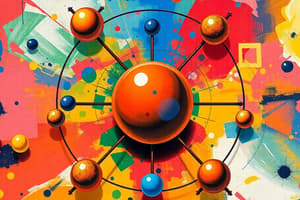Podcast
Questions and Answers
An atom is the smallest unit of matter.
An atom is the smallest unit of matter.
True (A)
_______________ discovered that the nucleus is the positively charged center of the atom.
_______________ discovered that the nucleus is the positively charged center of the atom.
Rutherford
What is an isotope?
What is an isotope?
- An atom with the same number of protons but different number of neutrons (correct)
- An atom with the same number of electrons but different number of protons
- An atom with the same number of neutrons but different number of protons
- An atom with the same number of protons and neutrons
What is the sum of protons and neutrons in an atom called?
What is the sum of protons and neutrons in an atom called?
Match the following scientists with their contributions:
Match the following scientists with their contributions:
Thomson's Model proposed that electrons move in orbits around the nucleus.
Thomson's Model proposed that electrons move in orbits around the nucleus.
The average mass of all isotopes of an element is known as its _______________.
The average mass of all isotopes of an element is known as its _______________.
What are valence electrons?
What are valence electrons?
What are compounds?
What are compounds?
A neutron is a particle in the nucleus with a positive charge.
A neutron is a particle in the nucleus with a positive charge.
Flashcards are hidden until you start studying
Study Notes
Atomic Theory
- An atom is the smallest unit of matter.
Dalton's Atomic Theory
- Atoms of the same element have the same mass.
Thomson's Model
- Thomson's Model proposes that electrons move in orbits around the nucleus.
The Cloud Model
- The Cloud Model suggests that electrons do not move in fixed orbits around the nucleus.
Atomic Structure
- A neutron is a particle in the nucleus with no charge.
Atomic Discovery
- Ernest Rutherford discovered that the nucleus is the positively charged center of the atom.
- Niels Bohr suggested that electrons move in orbits around the atom's nucleus.
Atomic Terms
- The sum of protons and neutrons in an atom is called its mass number.
- Dmitri Mendeleev discovered and published the first periodic table.
- The average mass of all isotopes of an element is known as its atomic mass.
Isotopes
- An isotope is an atom with the same number of protons but a different number of neutrons.
Periodic Table
- Periods in the periodic table are rows.
- Valence electrons are electrons in the outermost energy level.
Physical Properties of Metals
- Metals have physical properties such as high luster, ductility, and malleability.
Compounds
- A compound is a substance formed with atoms of two or more elements together in fixed ratios.
Studying That Suits You
Use AI to generate personalized quizzes and flashcards to suit your learning preferences.



